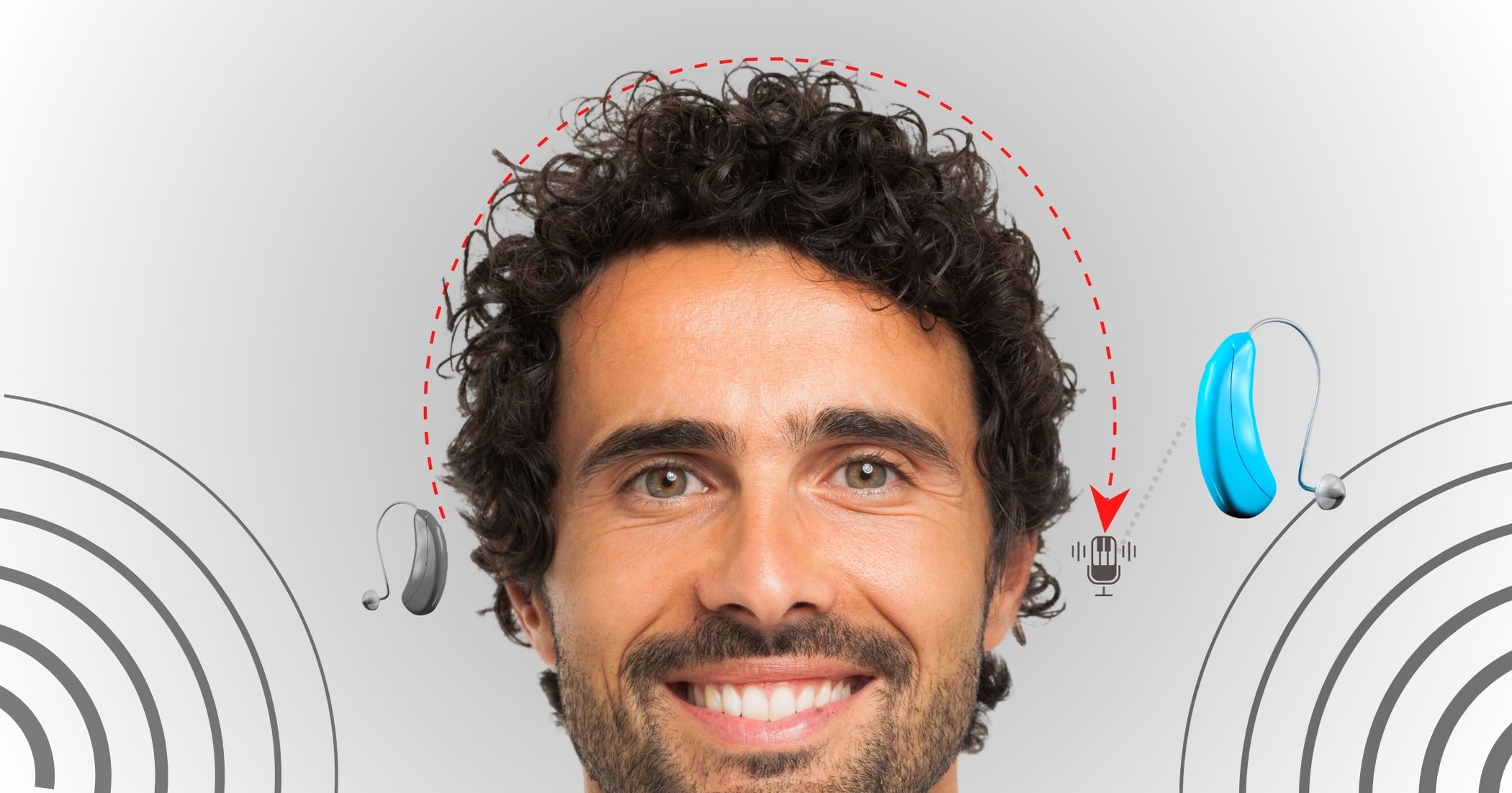Have you ever found yourself in a conversation with someone who instinctively turns their head to one side, claiming they can hear better that way? Chances are, they have a better ear.
While it’s a common assumption that hearing loss equally affects both ears, reality tells a different story. In the United States alone, over 60,000 people experience hearing loss in just one ear or have significant disparities in hearing between their ears.
Individuals exposed to excessive noise levels, whether through occupational or recreational activities, are at risk of unilateral hearing loss, as are those who have experienced trauma or injury to one side of their brain’s hearing centers. Additionally, children can be born with hearing loss affecting one or both ears, and untreated ear infections may lead to hearing loss in one ear.
Understanding CROS and BiCROS Hearing Aids
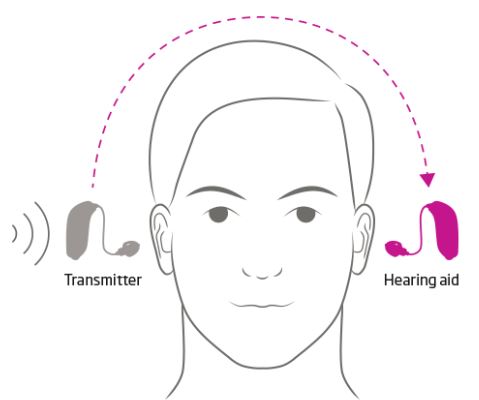
Image credit: Oticon
In this article, we will delve into the topic of CROS (Contralateral Routing of Signals) and BiCROS (Bilateral Contralateral Routing of Signals) hearing aids, specialized devices that accommodate to individuals with asymmetric hearing loss and explore how they have transformed the landscape of hearing healthcare.
- CROS vs. BiCROS Hearing Aids
- Why Not Rely on Better Ear Alone?
- Benefits of CROS/BiCROS Hearing Aids
- What Hearing Aid Brands Make CROS and BiCROS Devices?
- Limitations of CROS and BiCROS Hearing Aids
- Alternatives to CROS and BiCROS Hearing Aids
CROS vs. BiCROS Hearing Aids: What’s the Difference?
CROS and BiCROS hearing aids represent an innovative solution for those grappling with asymmetric hearing or single sided deafness (SSD).
While conventional hearing aids are primarily designed for individuals with hearing loss in both ears, CROS and BiCROS devices are engineered to address the unique challenges posed by hearing loss in just one ear or significant hearing disparities between the ears.
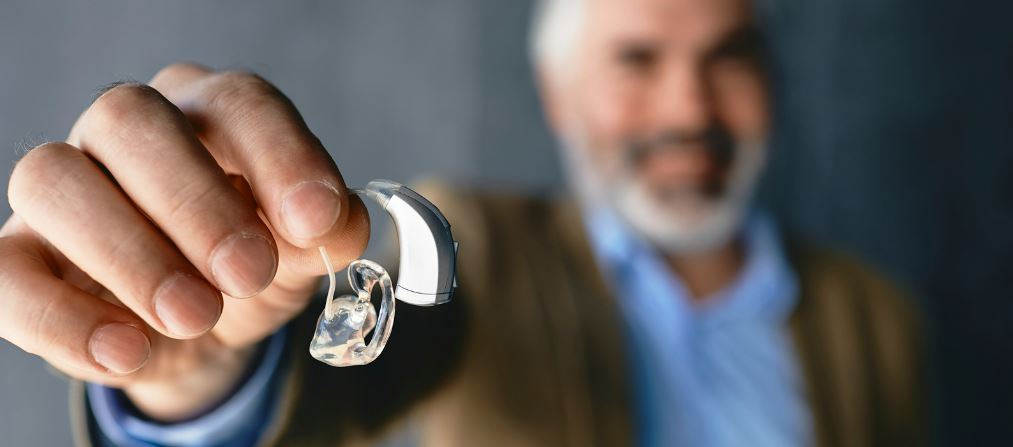
A CROS hearing aid system operates differently from conventional hearing aids. To qualify for a CROS hearing aid, an individual must have profound hearing loss, or no sound perception in one ear while maintaining normal hearing in the opposite ear.
A CROS device captures sound from the ear with poorer or no hearing and transmits it wirelessly to a receiver integrated into the hearing aid worn on the better ear.
While this may seem unconventional, the receiving hearing aid on the better ear does not amplify sound but rather delivers sound from the impaired ear. In essence, it bridges the gap in hearing.
The term “Bi” in BiCROS stands for bilateral, meaning both ears. BiCROS hearing aids operate on a similar principle to CROS devices but are tailored for individuals who have hearing loss in their “better” ear as well, although it remains significantly better than the poorer ear. In this case, the device on the better ear functions both as a hearing aid, amplifying sounds within the hearing loss range, and as a receiver, capturing sounds from the poorer ear.
The decision between CROS and BiCROS hearing aids hinges on an individual’s specific hearing loss and needs. The key distinction between CROS and BiCROS hearing aids is in the way they manage sound, making BiCROS devices suitable for those with varying degrees of hearing loss in both ears.
The candidacy for these types of devices are determined based on a comprehensive evaluation and diagnosis conducted by an audiologist or hearing care professional, as they are not typically sold over the counter. These experts assess will recommend the most suitable solution, ensuring that the chosen device aligns with the user’s unique requirements.
Further medical assessment by an Ear, Nose, and Throat (ENT) specialist may also be required to rule out underlying medical conditions associated with SSD or asymmetric hearing loss.

Why does some sounds not reach my better ear?
The answer lies in a phenomenon known as the “head-shadow effect.” When sound occurs on the side of the poorer ear, the physical barrier created by the head prevents optimal sound transmission to the better ear.
This effect is particularly noticeable with consonant sounds, which are crucial for speech understanding. It makes differentiating between similar-sounding words, such as “mat” and “fat,” much more challenging, especially in noisy environments like restaurants.
Why Not Rely on the Better Ear Alone?
Some individuals might argue that they can get by using their better ear alone. However, the benefits of binaural hearing -hearing with two ears, extends beyond simple sound perception.
Binaural hearing assists in sound localization, spatial orientation, and may help in maintaining balance, as hearing loss and balance are closely interconnected. Recent research has indicated that hearing aid use can lower fall risk.

The increasing adoption of CROS and BiCROS hearing aids has influenced technological advancements and innovative design. These devices now offer seamless between-ear signal transmission, enhanced noise reduction capabilities, and automatic adaptive directionality, resulting in an improved signal-to-noise ratio and greater speech intelligibility in various acoustic environments.
Furthermore, CROS and BiCROS hearing aids come equipped with features tailored to individuals with single-sided deafness (SSD) or asymmetric hearing loss, including moisture resistance, advanced feedback management, and tinnitus reduction options.
Benefits of CROS and BiCROS Hearing Aids
- Improved Sound Localization: CROS and BiCROS devices facilitate better sound localization, allowing users to pinpoint the direction of sounds more accurately.
- Enhanced Speech Understanding in Noise: These aids can significantly improve speech perception in noisy settings, making it easier to follow conversations amid background noise.
- Increased Comfort and Confidence: Users of CROS and BiCROS devices report enhanced comfort and confidence in social situations, enabling active participation in conversations and group activities without the frustration of missing vital auditory cues.
Which Brands Make CROS and BiCROS Hearing Aids?
In the past, only a few companies have made CROS and BiCROS devices. However, in recent years, a growing number of hearing aid manufacturers have begun making this feature available in their prescription hearing devices.
Below is a list of companies and current hearing aids that offer a CROS/BiCROS feature:
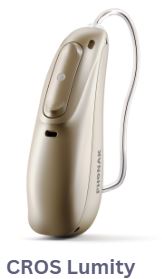 Phonak has been one of the leaders in offering CROS/BiCROS hearing aids and have done so for many years. The company’s latest hearing aid platform, Lumity, recently announced an expansion to offer this functionality.
Phonak has been one of the leaders in offering CROS/BiCROS hearing aids and have done so for many years. The company’s latest hearing aid platform, Lumity, recently announced an expansion to offer this functionality.
The CROS Lumity offers rechargeable functionality and is available in a range of technologies – from entry level (L30) to the premium (L90) level.
 Signia has been offering CROS/BiCROS functionality on its last few platforms, with the latest IX platform being the latest to add this feature. This feature, however, is not only limited to the RIC style (Pure Charge&Go), but is also available on the company’s new rechargeable Silk IX, which is a standard fit CIC that uses the same domes as the RIC devices.
Signia has been offering CROS/BiCROS functionality on its last few platforms, with the latest IX platform being the latest to add this feature. This feature, however, is not only limited to the RIC style (Pure Charge&Go), but is also available on the company’s new rechargeable Silk IX, which is a standard fit CIC that uses the same domes as the RIC devices.
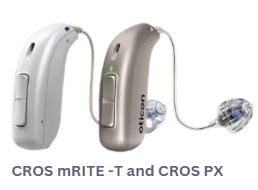 Oticon began offering a wireless CROS solution not long after the release of its successful Opn devices, and the company’s latest hearing aid family, Oticon Real, is also compatible with CROS/BiCROS options. The company currently offers the Oticon CROS and the rechargeable CROS PX in up to 7 color options.
Oticon began offering a wireless CROS solution not long after the release of its successful Opn devices, and the company’s latest hearing aid family, Oticon Real, is also compatible with CROS/BiCROS options. The company currently offers the Oticon CROS and the rechargeable CROS PX in up to 7 color options.
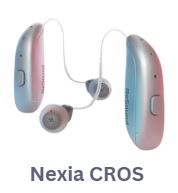 ReSound has not had a CROS/BiCROS option until its latest product, Nexia was released in late 2023. The company’s newest Nexia devices are equipped with Bluetooth LE audio and Auracast compatible, and are said to be 25% smaller than its standard size RIC hearing aids.
ReSound has not had a CROS/BiCROS option until its latest product, Nexia was released in late 2023. The company’s newest Nexia devices are equipped with Bluetooth LE audio and Auracast compatible, and are said to be 25% smaller than its standard size RIC hearing aids.
Starkey has offered a CROS option on their last few hearing aid platforms. Most recently, their Evolv AI devices offered 3 different styles for CROS/BiCROS function: 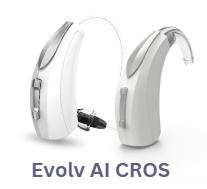 Rechargeable RIC, or battery-powered RIC and BTE options.
Rechargeable RIC, or battery-powered RIC and BTE options.
There has not yet been an announcement if the company’s new Genesis AI platform has CROS/BiCROS options available.
Limitations of CROS and BiCROS Hearing Aids
Despite their many advantages, CROS and BiCROS devices are not without limitations. They do not restore true binaural hearing, which is crucial for sound localization and spatial orientation.
Additionally, the initial adjustment process can be more taxing than with conventional hearing aids, requiring a greater commitment to rehabilitation. These devices can sometimes be more expensive and requiring additional maintenance beyond traditional models.
Alternatives to CROS and BiCROS Hearing Aids
CROS and BiCROS hearing aids may not be suitable for everyone with asymmetric hearing loss. Alternative options include:
- Bone-Anchored Hearing Aids (BAHA): Surgically implanted BAHA devices conduct sound through bone vibrations and are suitable for those who cannot adapt to CROS or BiCROS systems or present with an unresolved middle ear pathology.
- Cochlear Implants: Cochlear implants are ideal for individuals with profound hearing loss in both ears, as they directly stimulate the auditory nerve, providing a sense of sound. Cochlear implants however have a strict candidacy and apply to a selected population determined by audiologists and hearing care professionals.
- Traditional Hearing Aids: In some cases, a traditional hearing aid in the impaired ear may suffice to enhance the hearing experience, although a number of variables can impact performance – including the amount of residual hearing and whether the individual’s word discrimination is severely impaired.
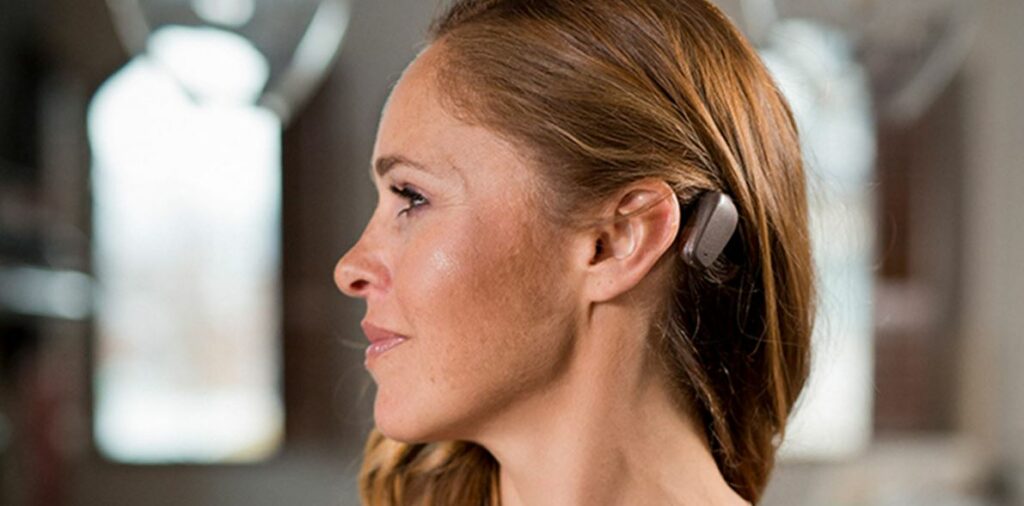
The bone anchored hearing aid (BAHA) is an increasingly popular option for those with single sided deafness and unilateral hearing loss. Image credit: Cochlear
Improving the Lives of People with Single Sided Deafness, Asymmetrical and Unilateral Hearing Loss
CROS and BiCROS hearing aids have revolutionized the way individuals with SSD or asymmetric hearing loss manage their condition. While these devices have their limitations, their positive impact on the quality of life of those with hearing loss in one ear cannot be overstated.
CROS and BiCROS devices can help mitigate the social and emotional consequences of unaddressed hearing loss and enhance overall communication abilities.
As technology continues to advance, we can expect even greater innovations in the field of hearing healthcare, further improving the lives of individuals living with hearing challenges.
References:
- Staab, W. The First CROS Hearing Aids. Hearing Health & Technology Matters. September, 2017. https://hearinghealthmatters.org/waynesworld/2017/the-first-cros-hearing-aids/
- Ajmera, R. Cros and BICROS Hearing Aids. Forbes. August 2023. https://www.forbes.com/health/hearing-aids/cros-bicros-hearing-aids/
- Hear.com. Cros and BiCROS Hearing Aids. https://www.hear.com/hearing-aids/types/cros-bicros/
- Ehrenfeld, T. What are CROS and BiCROS Hearing Aids? Healthy Hearing. July, 2020. https://www.healthyhearing.com/report/53113-What-are-cros-and-bicros-hearing-aids
- Action on Hearing Loss https://actiononhearingloss.org.uk
- NHS UK https://www.nhs.uk
- Health Research Funding. 17 CROS Hearing Aid Pros and Cons. https://healthresearchfunding.org/17-cros-hearing-aid-pros-and-cons/
- Vial. Cros and BICROS Hearing Aids in Clinical Research. https://vial.com/blog/articles/cros-bicros-hearing-aids-in-clinical-research/
About the Author
 Nausheen Dawood is an experienced Audiologist and Project Manager with a professional background including primary health care, corporate social investment, and business development. Proficient in the development of academic courses, training, and lecturing, with a focus on clinical student training and supervision. Adept in freelance copywriting, particularly in audiology and health-related topics. Holds a Masters degree in Audiology (Cum Laude), with a strong foundation in clinical research, project development, and strategic planning, complemented by technical training. Specializes in content development and training tailored to diverse audiences. Demonstrates a long-term commitment to research and development, including the implementation of randomized controlled trials, projects, and clinical examinations. Known for establishing robust networks and cultivating valuable stakeholder relationships.
Nausheen Dawood is an experienced Audiologist and Project Manager with a professional background including primary health care, corporate social investment, and business development. Proficient in the development of academic courses, training, and lecturing, with a focus on clinical student training and supervision. Adept in freelance copywriting, particularly in audiology and health-related topics. Holds a Masters degree in Audiology (Cum Laude), with a strong foundation in clinical research, project development, and strategic planning, complemented by technical training. Specializes in content development and training tailored to diverse audiences. Demonstrates a long-term commitment to research and development, including the implementation of randomized controlled trials, projects, and clinical examinations. Known for establishing robust networks and cultivating valuable stakeholder relationships.



